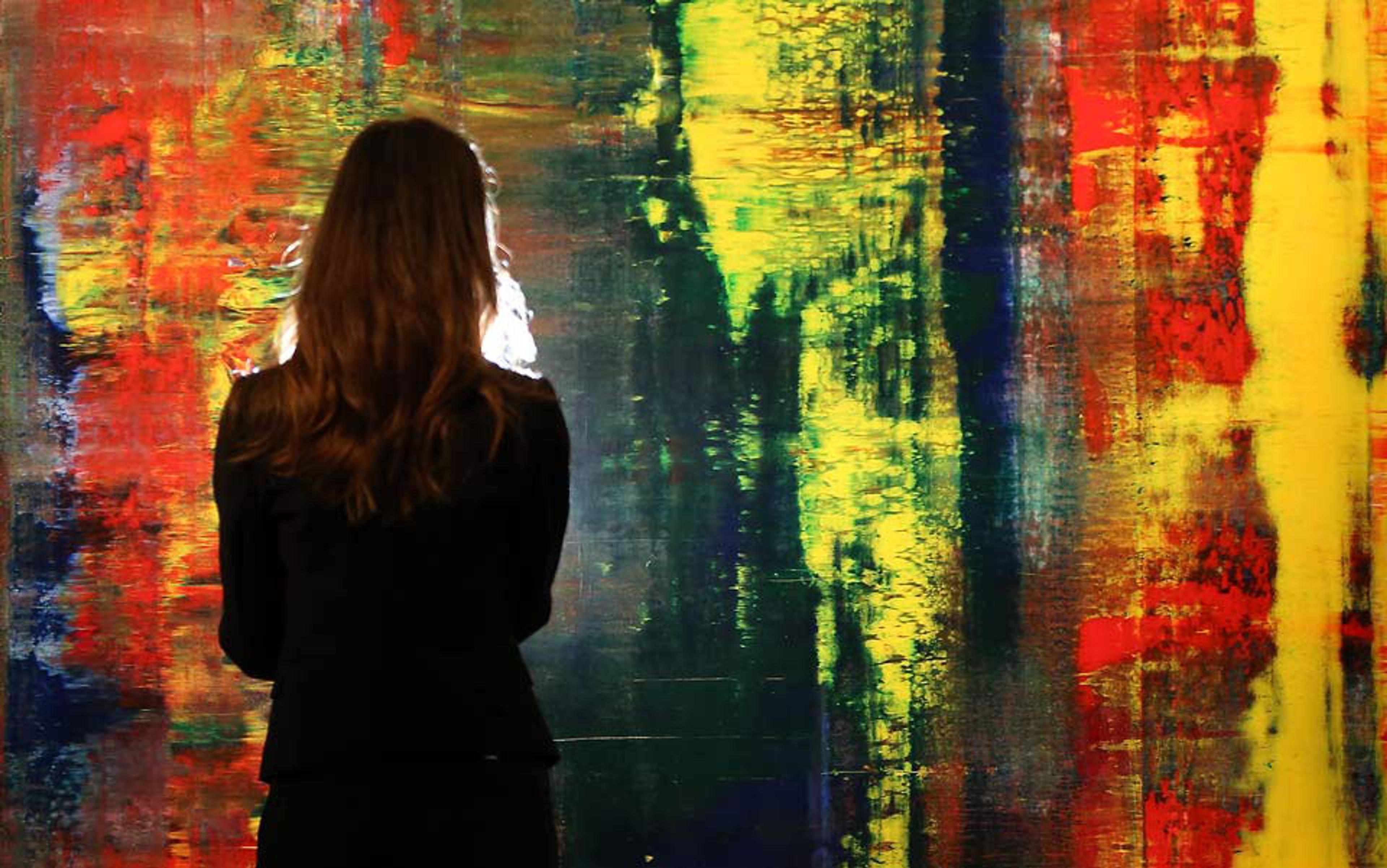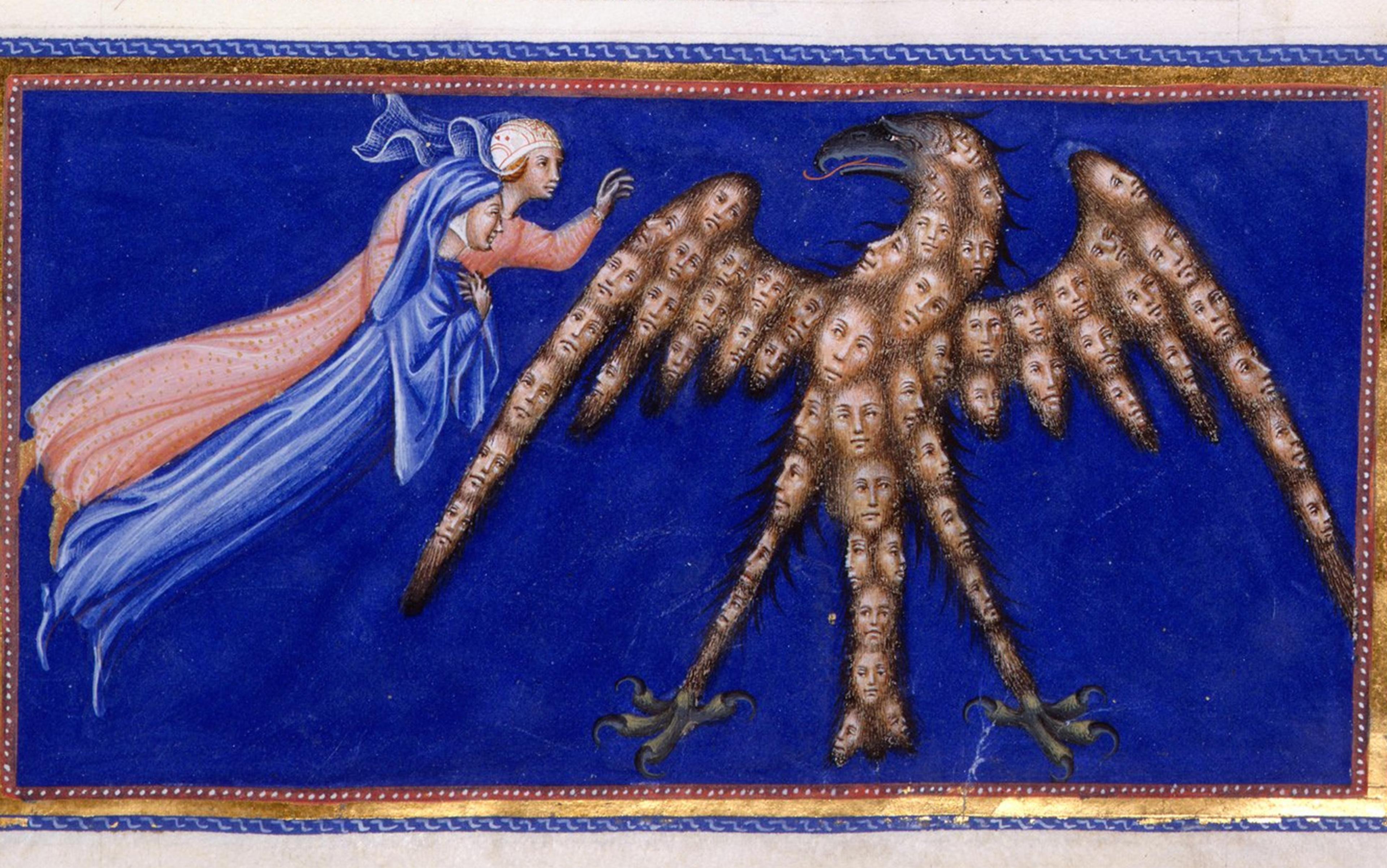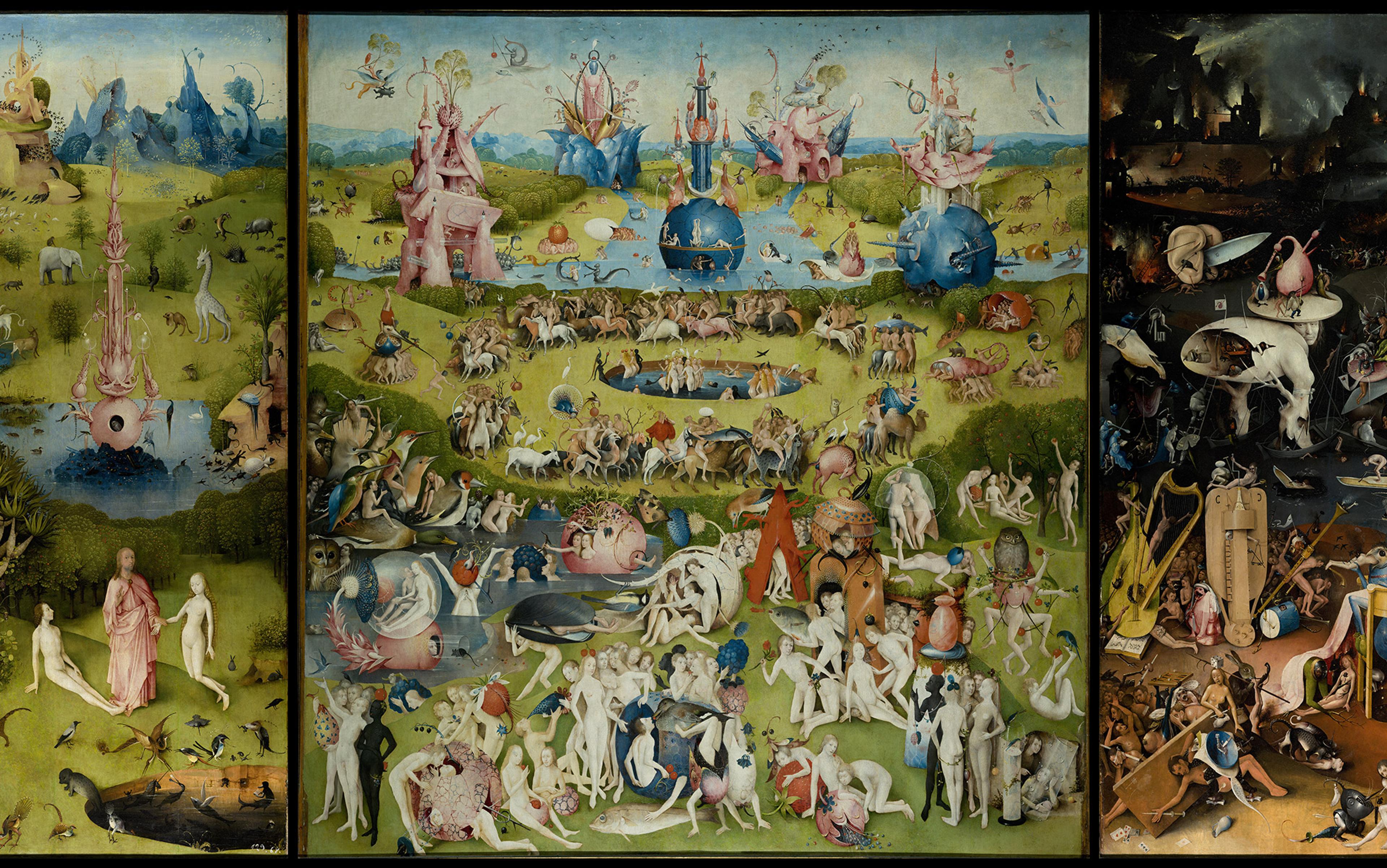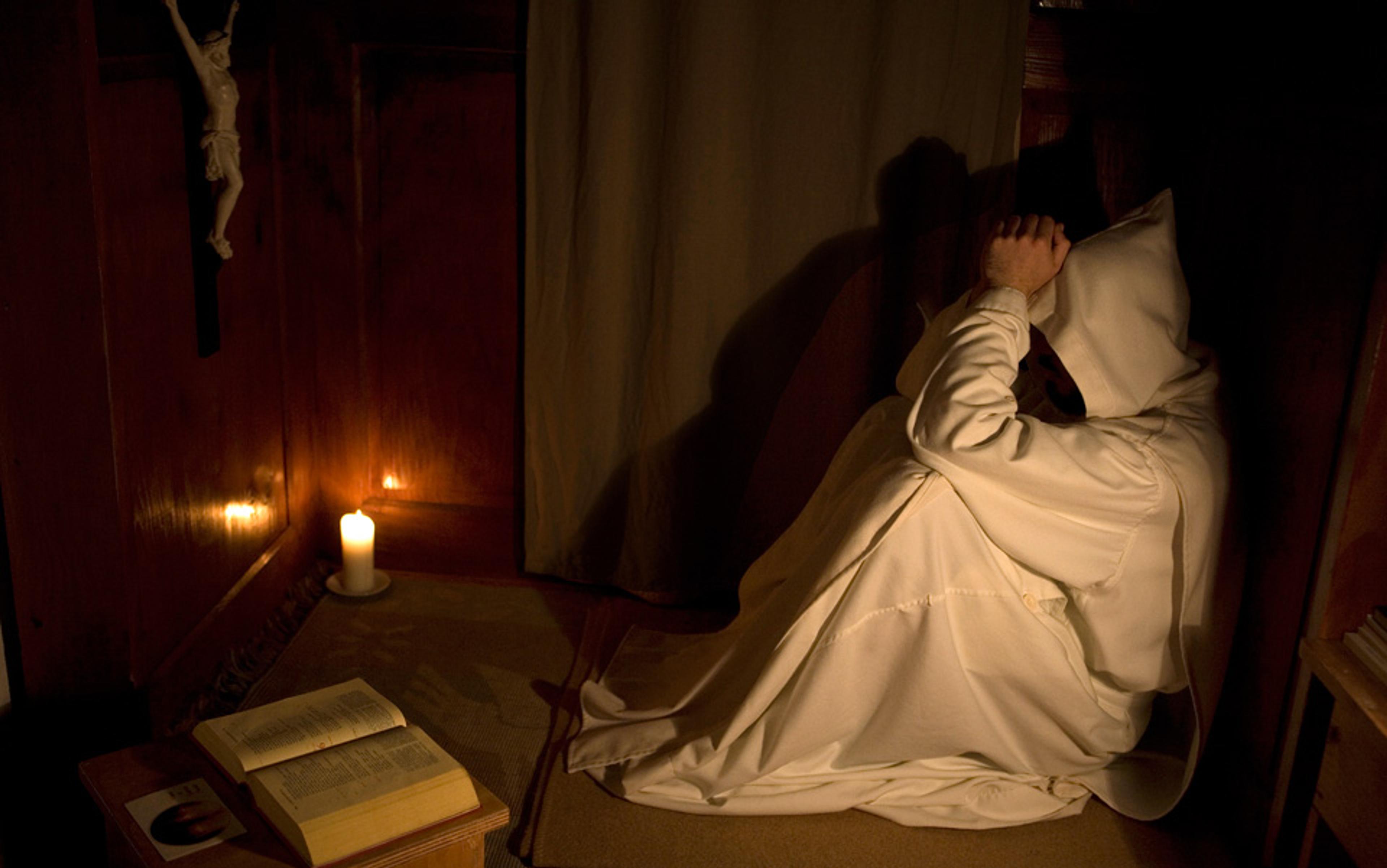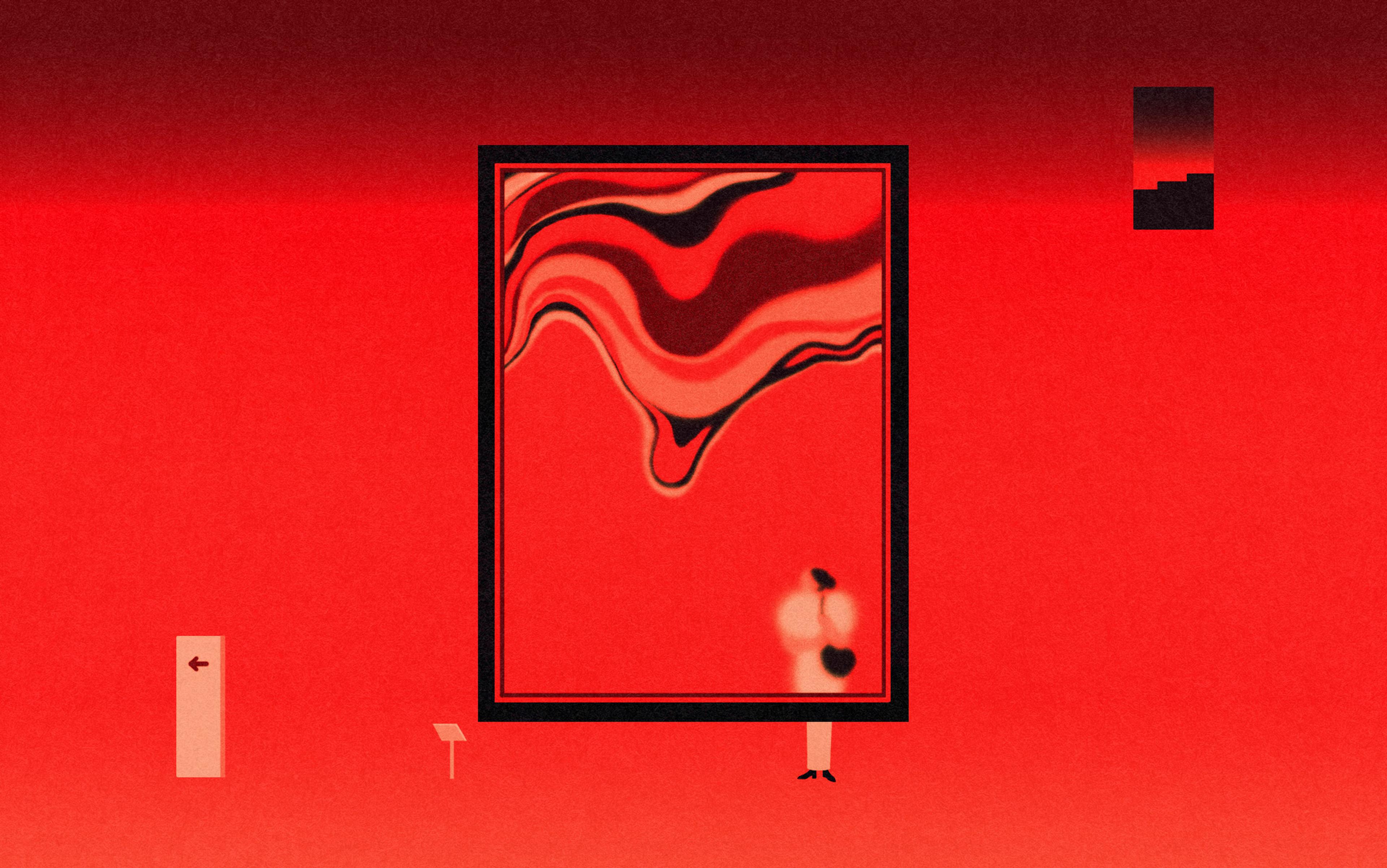The loveliest image I know is Fra Angelico’s ‘Entry of the Blessed into Paradise’, a scene from his painting The Last Judgment of 1431. In it, the blessed, just risen from their graves, gather together in a flowering garden to join hands with angels and dance into the light of heaven. There’s a scene in D H Lawrence’s novel The Rainbow (1915) when Anna Brangwen sees a copy of the image, and finds it almost too beautiful to look at. ‘The floweriness, the beams of light, the linking of hands, was almost too much for her, too innocent,’ writes Lawrence. Overwhelmed, she weeps ‘with happiness’.
I understand Anna’s feeling; I’d never been moved to tears by a painting before, but I was when I saw this one a few months ago in Florence. Yet if I step back and take in The Last Judgment as a whole – the saved on one side, welcomed by angels; the damned on the other, herded by devils; the celestial host above them, directing it all – it strikes me as an odd painting for a secular person to love. The Last Judgment is more than a work of art. It’s a profession of faith – in divine justice, the communion of saints, the resurrection of the body, life everlasting. What does it mean for a person like me to love a painting like this? What does it mean to be moved by the beauty of a vision you can’t believe to be true?
Questions such as these hum in the background of every secular experience of sacred art. But in the Museum of San Marco, where The Last Judgment hangs, they resonate more than usual. The museum was once a convent, home to generations of friars for whom a painting such as this would have had the status of revealed truth. The convent is most famous for a series of frescoes Angelico painted there, all on spiritual themes, for the friars’ silent, solitary contemplation. Standing today where the friars once stood, looking at images they once looked at, I felt, more vividly than in ordinary museums, both my distance from their world and a peculiar closeness to it.
It’s the remoteness of that world that struck me first. The friars of San Marco were Dominicans of a special sort – ‘strict observers’, committed to living in absolute accordance with the rules Saint Dominic had laid down for the Order when he founded it in 1216. They belonged to the Dominican Observance, a reform movement that had sprung up within the Dominican Order in the 1390s, around the time Angelico was born. They urged a return to the austere way of life of the earliest Dominican friars, which meant, among other things, enduring long fasts, keeping silence at meals and in the dormitories, disciplining oneself with a scourge, sleeping on a hard, narrow bed, and rising to pray at three every morning. Not everyone in the order went for it, but those who did were committed. They lived in special, ‘observant’ houses. When Angelico took the Dominican habit, sometime around 1420, changing his name from Guido di Pietro to Fra Giovanni, he joined an observant house.

Entry of the Blessed into Paradise detail from The Last Judgement by Fra Angelico, 1431. Museo di San Marco, Florence. Photo by: Leemage/UIG/Getty Images
In the 1430s, the Observance expanded into Florence. They set their sights on San Marco, a well-placed, but dilapidated, Silvestrine monastery near the heart of the city. They had the Pope on their side, as well as the powerful Medici family, and soon San Marco was theirs. To decorate the inside, the Dominicans hired Angelico. He was an obvious choice, being both an observant friar and a brilliant painter. And he was well known by then: his next commission would come from the Pope.
By 1445, Angelico and his assistants completed more than 50 paintings and frescoes for San Marco, reserving the most spectacular paintings for the public spaces downstairs. The Crucifixion with Saints, in the chapter room, is particularly striking. It’s a brilliantly coloured, semi-circular fresco more than 30 feet wide. Christ and the two thieves hang on crosses at the centre; below them, 20 life-sized figures – a mix of historical witnesses and saints – respond to the crucifixion, each one revealing his or her sorrow in a different way. When Henry James visited San Marco in 1873, he found himself transfixed by the image. ‘I looked long,’ he wrote, in Italian Hours (1909), ‘one can hardly do otherwise.’
A friar in Angelico’s time would have had a bed, a prayer desk and chair, and a small fresco as an aid to contemplation
The Crucifixion was intended for an audience of many, but most of the frescoes at San Marco were for audiences of one: one per cell, upstairs where the friars slept. They’re more modest than the others, and more mysterious. These were private, secluded spaces; looking into them today, you have the pleasure of seeing something long hidden from view.
The cells themselves are beautiful, in an austere way – small, spare, with low, curved ceilings, terracotta floors and walls painted the colour of white clay. A friar living there in Angelico’s time would have had a bed, a prayer desk and chair, and a small fresco, painted on the wall near the window, as an aid to contemplation. The theme of the fresco would have depended on the kind of friar he was. If he were a novice, he’d look at an image of Saint Dominic at prayer; if a laybrother, a narrative scene from the life of Christ; if an ordained priest, a more complex and poetic image, on a liturgical theme.
The most famous of these is the Annunciation in Cell 3. It shows a familiar scene: it’s sunrise, and the angel Gabriel has just made his announcement to the Virgin Mary, who kneels in a gesture of humility and assent. Angelico has made the scene strange by including a man who could not have been there: Peter Martyr, a 13th‑century Dominican saint, who stands watching Gabriel and Mary, his hands folded in prayer. Look closely and you see that the whole scene appears to be taking place just downstairs from Cell 3, in the cloister at San Marco. The fresco isn’t a depiction of an event; it’s more like a thought, or an invitation to thinking. It invites the viewer to contemplate, along with Peter Martyr, the immanent truth of the Annunciation.
All of the priests’ frescoes are in this mode. What Mark Rothko said of his own late works might be said of these: ‘They are not pictures.’ They are something else – something more like instruments of spiritual attunement.
Earlier this year, I stood in front of the fresco in Cell 3, trying to imagine it through the eyes of the friars who lived there. There’s so much to love about it – its beautiful palette of pinks, purples, greens and greys; the way the curve of Gabriel’s wing echoes the curve of the ceiling above him; how the play of light on stone conveys a sense of the freshness of morning. In Fra Angelico at San Marco (1993), William Hood writes that looking at this fresco, with its shimmering glazes of colour, is ‘like looking at nature reflected in a pearl’, and the description is exactly right.
The intimacy of the setting puts me in mind of the friars, but it also reminds me of my distance from them. It makes me think of the fresco’s place in their everyday lives, its involvement in complex, spiritual practices I hardly understand. However much I love it, I’ll never be able to see it the way the friars of San Marco did.
During the last major show of Fra Angelico in New York in 2005, the art critic Hilton Kramer described the utter strangeness of seeing a woman ‘demonstrably offering her prayers to a painting of the Holy Virgin’ in the middle of the Metropolitan Museum of Art. ‘There was no mistaking the piety and ardour that this woman brought to her act of worship; she was clearly oblivious to the group of onlookers that had silently gathered to witness her prayers,’ he wrote in the New York Observer.
Most of us are like those onlookers. We are unable to relate to the paintings as the woman does, yet curious about her response, maybe even a little awed by it. We have our own modes of appreciation – aesthetic, historical, technical. But it’s hard not to feel, in the face of her devotion, that there’s something peripheral about our responses – that the main event is happening elsewhere.
As he looked at The Crucifixion with Saints, James, too, wondered about the distance between Angelico’s world and his own. ‘You may be as little of a formal Christian as Fra Angelico was much of one; you yet feel admonished by spiritual decency to let so yearning a view of the Christian story work its utmost will on you,’ he wrote of this painting whose very colours, he said, ‘seem dissolved in tears that drop and drop, however softly, through all time’. The Crucifixion makes a demand on us, even in spite of the infirmity of our faith.
For artists and writers interested in the fate of the sacred, Angelico has a special appeal, because he is the sacred artist par excellence – not merely a painter, but a Renaissance master; not only a friar, but nearly a saint (he was beatified in 1982). Take Lawrence, for example: he loved Angelico, and once claimed that the ‘greatest pleasure’ he ever got came from painting a copy of Flight into Egypt, ‘working from photographs and putting in my own colour’. In The Rainbow, Lawrence makes The Last Judgment something of a focal point. In this multi-generational novel, thought by many to be his best, Lawrence tells the story of the Brangwen family from about 1840 to 1905, as the agricultural, church-centred world of their ancestors gives way to the industrial, secular world of today. What becomes of the sacred, it asks, in an increasingly desacralised world? Lawrence approaches the question by describing the Brangwens’ attitudes toward specific, sacred things: a cathedral, a carving of Adam and Eve, a copy of The Last Judgment.
‘He did not care whether or not he believed in devils or angels. The whole conception gave him the deepest satisfaction’
One can see why Lawrence chose this painting for the role. It’s beautiful, of course. (‘There is no other picture of heaven that could be as great and rich and gripping,’ Rainer Maria Rilke said of it, after a trip to Florence in 1898.) More importantly, though, The Last Judgment sums up, with dazzling concision, the medieval, Christian way of looking at the world. It’s a way of looking that sees people not as winners and losers, but as sinners and saints, and that sees the universe as ordered, purposeful and just, rather than chaotic, blind and indifferent.
By the time The Rainbow opens, that’s already an old and unrecoverable way of seeing. Yet Anna and her husband Will are passionately drawn to the painting, a copy of which they own. For Will, looking at it fulfills a deep, spiritual need – an irrepressible, if outmoded, longing for the absolute. He sometimes rushes home early just to admire it: ‘It had to do with the establishment of a whole mystical, architectural conception which used the human figure as a unit. … He did not care whether or not he believed in devils or angels. The whole conception gave him the deepest satisfaction, and he wanted nothing more.’
Anna loves it differently. The joy of the blessed moves her because it reminds her of her own joy, as a young wife and new mother; it reflects her happiness back to her, and helps her articulate it to herself. ‘Day after day came shining through the door of Paradise, day after day she entered into the brightness,’ she thinks, borrowing from Angelico’s imagery to describe her own bliss. ‘How happy she was, how gorgeous it was to live.’ Neither Will nor Anna believes in the literal truth of what The Last Judgment depicts, yet the painting is very much alive for them – gripping, relevant, even indispensable.
The novelist Vladimir Nabokov also kept Angelico close to hand – an ‘unframed, faded, and dusty reproduction of Fra Beato Angelico’s L’Annunciazione,’ his son Dmitri tells us. He had it on his desk, and must have looked at it often. Like Will Brangwen, Nabokov was drawn to older, more mystical ways of seeing. He wasn’t religious and, in his autobiography Speak, Memory (1951), at times admits to feeling chilled by the thought of the ‘two eternities of darkness’ that bracket our short lives. Yet the universe felt ordered and benevolent to him, and he continually defended these instincts against the forces of ‘common sense’ that sought to explain them away.
The benevolence of the universe was most apparent to Nabokov when he was hunting butterflies – which might explain his affection for this particular print. The wings of the angel, Dmitri writes, had a butterfly-like pattern, which his father, in a note beneath the picture, had described: ‘A recollection of Iphiclides podalirius with a slight dash of Papilio machaon and perhaps a hint of the day-flying moth Panaxia quadripunctaria.’ Nabokov had been an avid hunter from age seven, when his ‘guiding angel (whose wings, except for the absence of a Florentine limbus, resembled those of Fra Angelico’s Gabriel)’ pointed out a swallowtail in the front garden.
Nabokov was always noncommittal when it came to talking about his spiritual beliefs, but he occasionally had mystical moments, of ‘timelessness’ and ‘ecstasy,’ that he found hard to explain. Such moments, he writes, occurred in their highest form while standing ‘among rare butterflies and their food plants’. Perhaps he remembered those moments at his desk, as he looked at this picture of Gabriel, with his rare swallowtail wings.
These are joyful responses to Angelico. James, Lawrence, the Brangwens, Nabokov all celebrate his paintings as a source of pleasure and inspiration, and suggest a possibility of correspondence with his world. Nabokov makes room for Angelico at his desk, and in that gesture I see the emblem of something larger – an act of making room for mystery and transcendence in a world without much room for them.
Rothko was also influenced by Angelico. When first touring Europe in 1950, Rothko was unimpressed by most of the art he saw. ‘I looked at hundreds of madonnas, but all I saw was the symbol, never the concrete expression of motherhood,’ he said. But San Marco was an exception. He spent hours admiring the cell frescoes, and more hours talking about them with Giulio Carlo Argan, an Italian art historian who had just written a monograph on the painter.
After that, Angelico became a ‘beacon’ for Rothko, writes Dore Ashton, Rothko’s friend and biographer. In About Rothko (1983), she draws a link between Angelico’s hushed, solemn, otherworldly frescoes and Rothko’s own increasingly contemplative aesthetic. Rothko aspired to do what Angelico had done: create in the viewer a feeling of transcendence, of having been transported to another, purer world. The difference, of course, was that, for Rothko, there was no other world. There was only this one, and our longing for something more.
One especially feels this while looking at the vast, dark, almost black paintings he did for the Rothko Chapel in Houston, between 1964 and 1967. Like the frescoes at San Marco, which Rothko revisited in 1966, the Houston paintings are meant to create a spiritual ambience for the viewer, and serve as aids to meditation; the painter Robert Motherwell described them as ‘truly religious’. Yet they also invite more sombre interpretations. For Ashton, the deity they most call to mind is a fled one: what the 17th-century philosopher Blaise Pascal called Deus absconditus.
I love the story for its wonderful incongruities – 15th-century Florence, 21st-century LA; the world of faith, the world of fashion
In all of these cases, it’s some aspect of the moral content of Angelico’s paintings that makes a claim on the viewer – the joy of the blessed in The Last Judgment; the contemplative power of the cell frescoes; the particular architecture of Angelico’s Christian worldview. But there is another aspect of the paintings that makes a claim on us: their style. In 2011, Kate and Laura Mulleavy, of the avant-garde US fashion house Rodarte, visited Florence for the first time. ‘Everywhere we went, we cried,’ said Laura, but it was San Marco that made the biggest impression. The sisters were moved to tears by the beauty of the cell frescoes, and particularly by Angelico’s use of colour. They immediately began working on a collection inspired by his work, ‘thinking of each dress as something that could exist as part of a fresco’, said Laura. In 2012, in the Los Angeles County Museum of Art, they hung their Fra Angelico collection, a series of ethereal silk dresses in chalky San Marco shades of pink, blue, green and gold.
I love the story for its wonderful incongruities – 15th-century Florence, 21st-century LA; the world of faith, the world of fashion. Looking at photos of the installation, though, I’m not sure whether to count it among the lightest responses to Angelico’s work or the darkest. There’s no spiritual anguish here, no questioning or despair; just a remarkable instance of aesthetic inspiration, of beauty giving rise to more beauty. There’s something unnerving about the idea of reducing spiritual life to a style; about celebrating the forms of that life, while leaving behind the content; about the way the dresses just seem to float, of their own accord, in the centre of the room.
For a long time, I loved Angelico as the Mulleavy sisters did – for his use of colour, the way he played with pattern and proportion. He’s always been a favourite; years ago I spent two days in the Louvre in Paris, but all I remember seeing is his Coronation of the Virgin. Yet I hardly thought about the content of his paintings. I loved him for the reasons I loved abstract painters, and grouped him with Josef Albers, Ellsworth Kelly and Rothko in my mind. Whatever his appeal for me, I imagined it could be explained through some combination of colour theory, cognitive science, aesthetic philosophy and mathematics.
But something happened to me in Florence that which changed the way I see him. Before, I’d never encountered more than a couple of Angelico’s paintings at a time. At San Marco, I was surrounded by them. Half an hour into my visit, as I stood in the gallery downstairs, a funny feeling came over me, an extraordinary calm. I felt unusually centred, alert, open to the world, the way I’ve always imagined those Buddhist monks who change their brain waves through a lifetime of meditation must feel.
I noticed something about Angelico’s paintings that I hadn’t before. It had to do with the way his figures used their hands. His is a vision of the world as it might appear through the eyes of a compassionate God: a world in which everything has existential value and nothing is without meaning. What makes his paintings so moving is that the people in them share that vision. You see this in the way they reach out for one other, and touch everything gently, with infinite care, as though it were priceless. With every touch they seem to affirm the sacredness of the world. James had understood this from the start: ‘No later painter,’ he wrote in Italian Hours, ‘learned to render with deeper force than Fra Angelico the one state of the spirit he could conceive – a passionate pious tenderness … his conception of human life was a perpetual sense of sacredly loving and being loved.’
As I looked at the paintings, I realised I was mirroring, slightly, the way the figures carried themselves – the light but steady way they held their bodies, the graceful way they held their hands. This mirroring was the mechanism, I think, behind the sense of deep calm I experienced, a sense of having entered a new atmosphere. I felt I’d encountered an almost physical medium – something I could walk in, be immersed in, something that could change the climate in a room, and make everything feel sweeter, cooler, calmer, brighter than before.
To greet the world lovingly, with tenderness and joy – this, Angelico’s paintings imply, is what faith enables you to do
I had two thoughts then. The first was that I hadn’t really understood the art of painting until that afternoon. What really made painting great was its ability to create an atmosphere around itself, one you could be changed by 600 years later. The second was that I hadn’t thought my way into that mode of seeing. I hadn’t reflected on the values of Angelico’s world, and decided to adopt them for myself. It was more like I was seeing things by a new light – the calm, bright light of Angelico’s paintings.
It struck me that this is what faith is – not a set of propositions you hold to be true, or a set of rules you follow, but an atmosphere you live in, that changes your experience of the world, your sense of what and how things are. San Marco itself suggested the connection. Wasn’t that, after all, what the friars’ daily lives had been about, what all those special rituals and practices had been for? Those were the means by which the friars cultivated, and maintained, an atmosphere of faith – that very particular way of being in the world.
When I look at The Last Judgment now, it’s not the promise of an afterlife that moves me, or the notion that the universe is orderly and just. It’s the vision of a world in which everything matters, in which everything has weight and meaning. This, it seems to me, is the appeal of faith: it makes you feel the deep, intrinsic worth in things. I’m drawn to a certain detail in the painting, a little angel in the garden of the blessed, who is sweetly embracing a friar, just risen from his grave. To greet the world as the angel greets the friar, lovingly, with tenderness and joy – this, Angelico’s paintings imply, is what faith enables you to do.
The question, for a secular person, is how, in the absence of faith, one can come to experience the world that way. Is it possible to maintain a sense of the sacred, even in the absence of belief? My experience at San Marco suggests one answer. We might not believe in the things the friars did. But, perhaps, by taking up the practices they used to cultivate their faith – putting ourselves in the way of sacred art, for example – we can feel some of what they felt, recover some of that older, sacramental sense of weight and value. The loving, reverent attitude toward life; the sense that the world is bright with meaning; the intuition that existence is good; the openness to mystery, to experiences we don’t fully understand – these feelings, surely, are still relevant, and, to some degree, accessible, to us.

